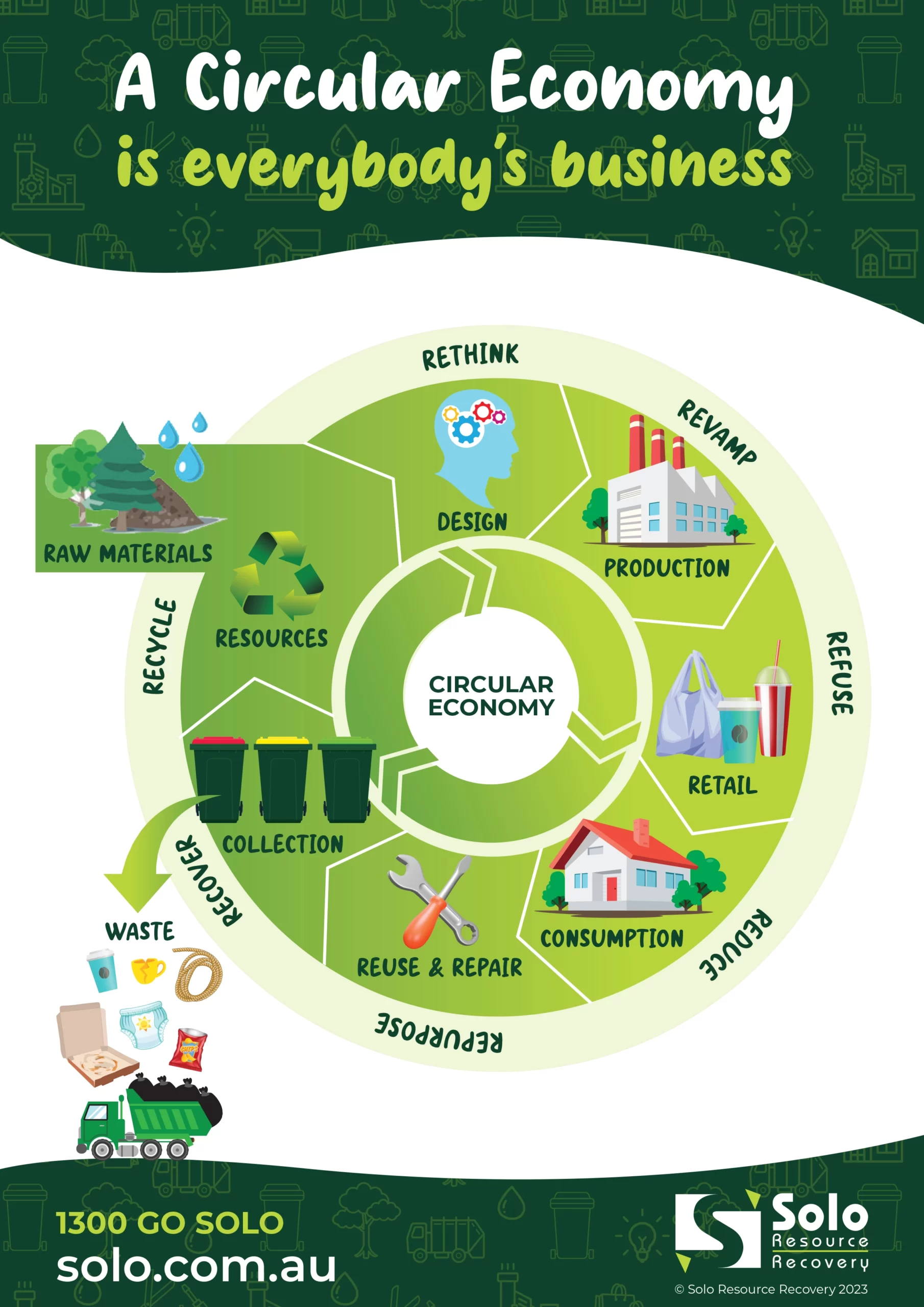Embracing the Circular Economy: Our Comprehensive Guide to the 7Rs
A Circular Economy is Everybody’s Business
With ongoing concerns over resource depletion and environmental degradation, the concept of a circular economy has gained traction as a sustainable alternative to the traditional linear economic model. The transition to a circular economy involves rethinking our consumption patterns, production processes, and waste management practices to create a closed-loop system that minimises waste, maximises resource utilisation, and fosters long-term ecological balance. Building upon the foundational principles of the 3Rs (Reduce, Recover, Recycle), the circular economy introduces four additional dimensions: Rethink, Revamp, Refuse and Repurpose. In this comprehensive guide we delve into the details of the 7Rs of the circular economy and explore their implications for a more sustainable future.

1. Rethink
To begin with, consider what type of consumer you want to be, and what your actions mean for the environment. As a business, what packaging you use can have a profound impact on what your customers send to landfill. We have an opportunity to rethink our choices, by acknowledging that the natural resources of the planet are limited, and that they need to be preserved for the future. To start, be mindful of what you buy. Ask yourself, do I really need this? Or can I obtain what I need another way? Embracing environmentally friendly alternatives will help to minimise the amount of waste that is generated, and by adopting this way of thought, you can play a role in creating a more sustainable environment for the future. Rethink is an invitation to design the best future moving forward.
2. Revamp
Revamping and improving processes are an important aspect of a circular economy. It involves reevaluating current practices, identifying weaknesses, and implementing improvements for increased efficiency and productivity. By leveraging technology and fostering innovation, processes can be improved for more environmentally friendly outcomes. Furthermore, with regular monitoring and adjustments in production (which align to the principles of a circular economy), industry practices will assist in meeting business objectives and improved consumer and environmental outcomes.
3. Refuse
The third dimension of the circular economy, refuse, challenges us to reconsider our overall approach to consumption and production. This involves adopting a holistic perspective that evaluates the entire lifecycle of products, from sourcing materials to end-of-life disposal. Refusing also prompts us to question the necessity of certain products and encourages innovative business models and practices, such as product-as-a-service and sharing economy platforms. By embracing the “refuse” principle, we can align our economic activities with our relationship to consumer products.
4. Reduce
At the heart of the circular economy lies the principle of reducing our consumption of finite resources. While traditional economic models encourage continuous growth, which ultimately has led to increasing natural resource extraction, the circular economy emphasises the importance of decoupling economic growth from resource consumption. Through the adoption of strategies such as; designing for longevity, incorporating sustainable materials, and minimising unnecessary packaging – benefits to the environment can be gained. When we embrace the “less is more” philosophy, we can significantly decrease the strain on our planet’s resources and mitigate the environmental impact of production and consumption.
5. Repurpose
The repurpose aspect of the circular economy focuses on extending the lifespan of products. This includes designing products for durability and ease of repair, as well as fostering a culture that values repair and reuse. This not only reduces the volume of discarded items but also creates economic opportunities within local communities. Repair Cafes, where skilled individuals help fix and repurpose broken items, are gaining popularity as they promote skill-sharing and community engagement, while reducing the throwaway culture.
6. Recover
The sixth pillar of the 7Rs, recover, extends beyond traditional recycling by encouraging the repeated use of products and materials. Recovering involves reimagining how we perceive ownership and the product lifecycle. Instead of the linear approach where products are discarded after single use, a circular economy encourages the creation of products that can be easily refurbished, remanufactured, or repurposed. Businesses can facilitate this by offering take-back programs, and by encouraging customers to return products at the end of their life for refurbishment or safe disposal. Recovery is essential to the success of diverting resources from landfill.
7. Recycle
Recycling is a familiar concept to most of us, but within the circular economy framework, it takes on an enhanced significance. Recycling involves transforming used materials into new products, which reduces the need for virgin raw materials. Advanced recycling technologies, such as chemical recycling and upcycling, are gaining prominence as they enable the conversion of complex waste materials, such as plastics, into high-quality materials for new products. Effective recycling systems require collaboration between governments, industries, and consumers to ensure proper waste separation, collection, and processing.
Addressing Common Questions
Q1: How does the circular economy differ from the traditional linear economy?
The traditional linear economy follows a “take-make-dispose” model, where resources are extracted, products are manufactured, used, and are then discarded as waste. The circular economy, on the other hand, promotes a closed-loop system where resources are used more efficiently through reducing, reusing, recycling, repairing, and rethinking, thus minimising waste, and environmental impact.
Q2: What role do businesses play in the circular economy?
Businesses are pivotal in driving the transition to a circular economy. They can design products for durability, create take-back programs, invest in recycling and refurbishing infrastructure, and explore innovative business models that prioritise resource efficiency over excessive consumption.
Q3: How can consumers contribute to the circular economy?
Consumers can contribute by making mindful purchasing decisions, favouring products with longer lifespans, and repairable designs. Additionally, participating in reuse initiatives, proper waste separation, and advocating for policies that promote the circular economy can make a significant impact.
Q4: Is the circular economy economically viable?
Yes, the circular economy presents economic opportunities through reduced material costs, new revenue streams from recycling and refurbishment services, and job creation in repair and recycling industries. Additionally, it reduces the risks associated with resource scarcity and price fluctuations.
Q5: Are there any challenges to implementing the circular economy?
Implementation challenges include changing consumer behaviour, transforming industries’ production processes, establishing efficient recycling infrastructure, and overcoming regulatory barriers. However, these challenges are not insurmountable, and many governments, businesses, and communities are already making the move toward circularity.
As the world grapples with the pressing need for sustainable solutions, the circular economy stands out as a holistic approach that addresses both environmental and economic concerns. By embracing the 7Rs (Rethink, Revamp, Refuse, Reduce, Repurpose, Recover and Recycle) – we can pave the way for a future where resources are used wisely, waste is minimised, and the delicate balance of our planet is preserved for generations to come.
The transition to a circular economy represents both an opportunity and a responsibility to redefine our connection and commitment to the planet.
Related Posts

Published: October 1, 2024
Is Your Waste Management Performance Up to Scratch? Discover the Solo Difference
Read more
Published: August 15, 2024
Solo Invests in the Future: Company Expands Fleet with Hydrogen Vehicles
Read more
Published: December 15, 2023